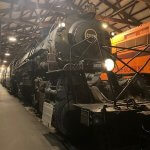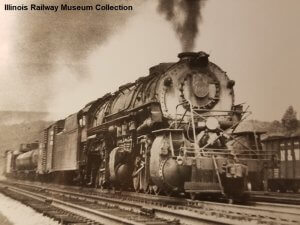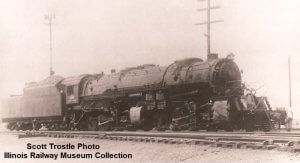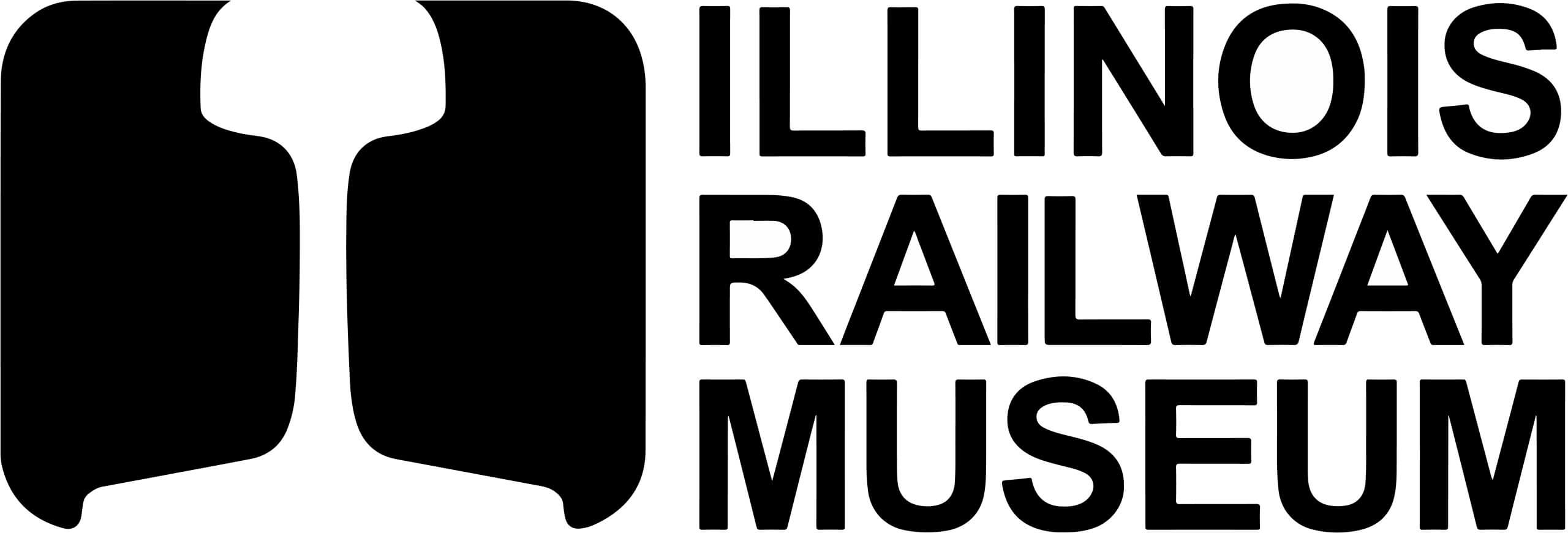Steam Engines

Norfolk & Western 2050
| Description: | 2-8-8-2 Mallet |
Equipment Information
Norfolk & Western 2050 is the only articulated steam engine preserved at IRM and one of only two 2-8-8-2 Mallet locomotives in existence. It is a United States Railroad Administration (USRA) standard design and saw use in low-speed drag freight service in the mountains of Virginia. It is a compound engine, which means that it uses steam twice: first in the rear (high pressure) set of cylinders and then in the front (low pressure) set of cylinders.
Norfolk & Western 2050 Details
Builder: American Locomotive Company
Year Built: 1923
Builder Number: 64070
Wheel Arrangement: 2-8-8-2
Length: 113ft
Width: 11ft 3in
Height: 15ft 8in
Weight: 539000 lbs
Brakes: 6ET
Tractive Effort: 114154lbs S / 136985lbs C
Cylinders: 25×32 / 39×32
Boiler Pressure: 270 psi
Drivers: 58in
Description: Class Y3A
Arrived: 1976
Condition: Complete / unrestored / not operational
 N&W 2050 in service, date unknown – Illinois Railway Museum Collection
N&W 2050 in service, date unknown – Illinois Railway Museum Collection
 N&W 2050 in 1936, Scott Trostle Photo, Illinois Railway Museum Collection
N&W 2050 in 1936, Scott Trostle Photo, Illinois Railway Museum Collection
Read more about the history of this engine in Rail & Wire #150
Ownership History
1923-1959 – Norfolk & Western
1959-1976 – Armco Steel, Middletown, OH
1976-present – Illinois Railway Museum, Union, IL
What was the Norfolk & Western Railway?
Engine 2050 is the only piece of equipment at IRM that was built for the Norfolk & Western, or N&W. The N&W was a railroad whose main line ran from Norfolk, VA, through West Virginia and northwest to Columbus, OH. Numerous branches served cities throughout Virginia, West Virginia, and as far northeast as Hagerstown, MD. Formed during the late 1800s through a series of merged smaller railroads, the N&W grew to rely predominantly on heavy bituminous coal traffic from along its main line. The railroad exported this coal, mined in West Virginia and southwestern Virginia, through the port at Norfolk and to markets in the Midwest and west.
The N&W also came to be known for distinctive steam locomotives that, much of the time, were designed and built in-house. The railroad built many articulated locomotives, including low-speed drag freight engines like 2050 and higher-speed fast freight locomotives. The N&W built these engines in its Roanoke shops, including the last steam locomotive built for a U.S. “Class One” railroad, in 1953. With abundant coal along its railroad, the N&W resisted the conversion to diesel-electric power longer than any other major railroad. But eventually, in 1965, the last N&W steam engines were retired.
In 1980, the N&W merged with the Southern Railway to form today’s Norfolk Southern.
Articulated Steam Engines
This huge locomotive was built for a single specific purpose: to push heavy coal trains up the mountain. The Pocahontas region has always been one of the nation’s chief sources of coal, so the Norfolk and Western railroad was built largely to transport coal from the mines to the coast for shipment. But there was never any way to avoid long, steep grades out of the valleys where the mines were located.
This is an “articulated” locomotive: you will see that it has two separate sets of driving wheels. The front set has a hinge connecting it to the rear set and the boiler, so the front set swings from side to side to go around curves. The engine has a huge boiler to generate as much steam as possible. This engine is also a “compound,” which means it uses steam twice. First, the rear cylinders use the steam at high pressure and then, after those cylinders exhaust the steam, the larger front cylinders use the steam again at lower pressure. The driving wheels are small, so the maximum speed is low, but this design maximizes the power the engine can exert to push a heavy train up a steep grade. The tractive effort is about 137,000 lbs. That means that in theory it could lift almost 70 tons straight up.
During World War I, a government agency called the U.S. Railroad Administration, or USRA, took over most of the major railroads. The USRA developed several standard steam locomotive designs, among them a heavy 2-8-8-2 for freight service. The N&W liked this design so much that after the USRA disbanded in 1922, they started building more locomotives to basically the same plan, with minor improvements. In fact, the N&W continued to refine the design and built basically the same locomotive until 1952.
The railroad had another design, the Class A, which was also an articulated but with fewer, much larger driving wheels. A Class A would be at the front of the train, and at the bottom of the grade, a Class Y like this one would couple onto the caboose and start pushing. Up a long steep grade they would go, perhaps only 10 MPH or less, but sooner or later they would reach the top of the ridge. Here the pusher would uncouple, and slowly roll back down the mountain to be ready for the next eastbound coal train. Meanwhile, the Class A up front could keep the train rolling at high speed on long downgrades and short upgrades, running at maximum speed towards tidewater at Norfolk.
After Diesels replaced steam, this particular locomotive became a stationary boiler at the Armco steel plant in Middletown, Ohio. For two decades it sat there, just steps from the blast furnaces melting down hundreds of other steam locomotives, until IRM rescued it in 1975. Since then, museum volunteers have cosmetically restored N&W 2050. Only one other locomotive of this wheel arrangement still exists.
Click to return to Steam Engine roster
Click to return to main roster page
